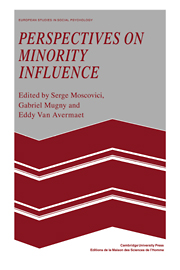Book contents
- Frontmatter
- Contents
- Contributors
- Preface
- Part I The process of minority influence
- Introduction
- 1 Innovation and minority influence
- 2 Social support and minority influence: the innovation effect reconsidered
- 3 Compromising public influence for private change
- 4 Conflict and conversion
- 5 Rigidity and minority influence: the influence of the social in social influence
- Part II Minority influence in groups
- References
- Subject index
- Author index
5 - Rigidity and minority influence: the influence of the social in social influence
Published online by Cambridge University Press: 05 February 2012
- Frontmatter
- Contents
- Contributors
- Preface
- Part I The process of minority influence
- Introduction
- 1 Innovation and minority influence
- 2 Social support and minority influence: the innovation effect reconsidered
- 3 Compromising public influence for private change
- 4 Conflict and conversion
- 5 Rigidity and minority influence: the influence of the social in social influence
- Part II Minority influence in groups
- References
- Subject index
- Author index
Summary
A research programme may develop out of an apparently trivial and limited question. Such was the case with our research on the influence of minorities. The point of departure for our studies of minority influence was as follows. Moscovici and his co-workers (Faucheux & Moscovici, 1967; Moscovici, Lage & Naffrechoux, 1969) argued that the basis of minority influence is consistency; by behaving in a closed, stable and coherent fashion over time (diachronic consistency), and by behaving unanimously (synchronic consistency), a minority generates a social conflict whose resolution may entail some influence. These hypotheses were substantially supported by experimental evidence, principally involving perceptual tasks. In these, confederates of the experimenter representing a minority position (both in terms of numbers, since the naive subjects were in the majority, and in terms of the norm, e. g. pretending to see as green a stimulus that appeared obviously blue to the subjects) markedly modified the responses of the majority. They did so by closed and systematic repetition of the same unchanging response (see Moscovici & Faucheux, 1972), or by responses that were a little more variable but were systematically correlated with variations in the stimulus (Nemeth, Swedlund & Kanki, 1974), or by the unanimity of their responses (see Moscovici & Lage, 1976).
All would have been straightforward had there not been a few inconvenient and apparently contradictory findings, or observations that were, at the very least, difficult to interpret within the framework of the initially formulated theory of consistency.
- Type
- Chapter
- Information
- Perspectives on Minority Influence , pp. 113 - 136Publisher: Cambridge University PressPrint publication year: 1985
- 7
- Cited by



